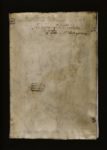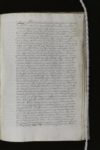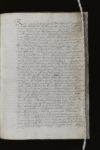 A manuscript translation of Tacitus’ Annales has been discovered to be the work of Queen Elizabeth I. The manuscript was identified by University of East Anglia researcher Dr John-Mark Philo who was looking for translations of Tacitus in the Lambeth Palace Library. It is a limp vellum binding of 17 folio pages whose title page (likely added at a later date and corrected even later) reads “An Essay of the Translation of
A manuscript translation of Tacitus’ Annales has been discovered to be the work of Queen Elizabeth I. The manuscript was identified by University of East Anglia researcher Dr John-Mark Philo who was looking for translations of Tacitus in the Lambeth Palace Library. It is a limp vellum binding of 17 folio pages whose title page (likely added at a later date and corrected even later) reads “An Essay of the Translation of Livy Tacitus 1st Booke of the Annals.” The manuscript wasn’t lost, but it was neglected, academically speaking. Even though it’s one of only four known early modern manuscript translations of Tacitus, it has never until now been subject of scholarship.
Dr Philo, who was a Leverhulme Trust Early Career Fellow when he made the discovery in January this year, said: “The manuscript features a very specific kind of paper stock, which gained special prominence among the Elizabethan secretariat in the 1590s. There was, however, only one translator at the Tudor court to whom a translation of Tacitus was ascribed by a contemporary and who was using the same paper in her translations and private correspondence: the queen herself.
“The corrections made to the translation are a match for Elizabeth’s late hand, which was, to put it mildly, idiosyncratic. The higher you are in the social hierarchy of Tudor England, the messier you can let your handwriting become. For the queen, comprehension is somebody else’s problem.
“The translation itself has been copied out in an elegant scribal hand, which is itself a match for one of Elizabeth’s secretaries, but the author’s changes and additions are in an extremely distinctive, disjointed hand – Elizabeth’s. Her late handwriting is usefully messy – there really is nothing like it – and the idiosyncratic flourishes serve as diagnostic tools.”
 Some of those known idiosyncrasies found in the corrections are the the top stroke of the ‘e’, an unusually horizontal ‘m’ and the broken stem of her ‘d’. The paper stock is characterized by a watermark of a lion rampant to the initial “G.B.” and a crossbow. This stock is found in many of the papers of Robert Cecil, son of Lord Burghley, Secretary of State and Lord Privy Seal of Queen Elizabeth I, whose secretaries used it for everything from letters to arrest warrants.
Some of those known idiosyncrasies found in the corrections are the the top stroke of the ‘e’, an unusually horizontal ‘m’ and the broken stem of her ‘d’. The paper stock is characterized by a watermark of a lion rampant to the initial “G.B.” and a crossbow. This stock is found in many of the papers of Robert Cecil, son of Lord Burghley, Secretary of State and Lord Privy Seal of Queen Elizabeth I, whose secretaries used it for everything from letters to arrest warrants.
The manuscript is short, translating only the first book of the Annales which, after a brief introduction about the end of the Republic, covers the final acts of Augustus, his death in 14 A.D. and the first two years of Tiberius’ reign. In the late 16th century, Tacitus’ account of tyranny, torture, betrayal and depravity at the courts of the early emperors were held up as political cautionary tales, negative examples for any righteous and moral monarch to take to heart. One translator of the Annales, Flemish humanist Justus Lipsius, included extensive quotations from the ancient author in his very popular Politica. Published in 1589, Politica was a defense of strong centralized monarchy. Tacitus’ chronicles were used to illustrate how an enlightened modern ruler, unlike the ones Tacitus was dealing with, should behave.
The timing of the translation ties it to this trend in scholarship. Elizabeth could well have translated the Annales to absorb the lessons from some of history’s choicest tyrants. She could also have had an interest in some of the other personages depicted. Dr. Philo muses:
“It is hard not to wonder what Elizabeth made of Agrippina, ‘who’, as Elizabeth translates it, being a woman of a great courage, ‘tooke upon hir some daies the office of a Captaine’ and is able to rouse the troops successfully. It is not unreasonable to assume that Agrippina may have appealed to the same queen who addressed the soldiers at Tilbury, and who had deliberately represented herself as placing the importance of addressing her troops in person above her personal safety.”
Or she could have done it purely for her own intellectual enjoyment. Poet and historian John Clapham wrote in Certain Observations Concerning the Life and Reign of Queen Elizabeth in 1603:
She took pleasure in reading of the best and wisest histories, and some part of Tacitus’ Annals she herself turned into English for her private exercise. She also translated Boethius, De Consolatione Philosophiae, and a treatise of Plutarch, De Curiositate, with diverse others.
That Boethius translation, btw, was also written on the rampant lion-GB-crossbow stock.
 The provenance of the manuscript links it to the Tudor court as well. It is catalogued as part of the collection of Thomas Tenison, Archbishop of Canterbury (1636–1715), who had a significant number of documents from the court of Elizabeth I. He bequeathed his book collection to his successors, which is how it entered the library of Lambeth Palace, official London residence of the Archbishop of Canterbury.
The provenance of the manuscript links it to the Tudor court as well. It is catalogued as part of the collection of Thomas Tenison, Archbishop of Canterbury (1636–1715), who had a significant number of documents from the court of Elizabeth I. He bequeathed his book collection to his successors, which is how it entered the library of Lambeth Palace, official London residence of the Archbishop of Canterbury.
The manuscript has been fully digitized and can be perused here. Dr. John-Mark Philo’s study of the manuscript has been published in the The Review of English Studies and can be read here.
——–
“In pedite robur; quaedam nationes et curru proeliantur. Honestior auriga, clientes propugnant. Olim regibus parebant, nunc per principes factionibus et studiis trahuntur. Nec aliud adversus validissimas gentis pro nobis utilius quam quod in commune non consulunt…”
:confused:
‘Their strength is in infantry. Some British tribes also use chariots. The higher in rank is the charioteer; the dependants fight. While they were once ruled by kings, they are now divided under chieftains into factions and parties, and nothing else is more advantageous to us in dealing with their strong nations than that they do not act in cooperation…’
——–
(Tacitus: ‘Agricola’, XII)
As a teacher of current elementary school students, I find her handwriting very legible.